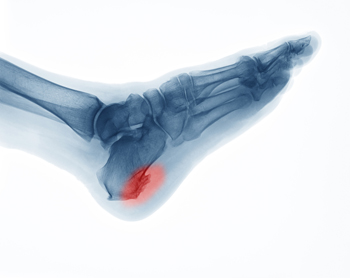- Home
- Our Doctors
- Our Offices
- New Patients
- Patient Education
- Blog
- Contact Us
- Patient Portal Help



Protecting and caring for your heels is a critical component of maintaining proper foot health. However, a heel spur is a troublesome condition that can negatively impact your heels’ vigor. Heel spurs, also referred to as calcaneal spurs, are essentially bony bulges that form on the heel bone either on the back of the heel or under the sole of the foot. Heel spurs usually develop in response to plantar fasciitis and especially when stress is exerted on the plantar fascia for an extended period of time. Individuals who are middle-aged or overweight may be at an increased risk of developing this unfortunate foot affliction. Although some cases of heel spurs are asymptomatic and do not produce pain, many individuals with heel spurs can experience heel pain when beginning to walk after a period of rest. If you have a case of heel spurs, a podiatrist can help you address the condition. If your heel spurs are related to plantar fasciitis, they might be treated with orthotics such as night splints, heel inserts, or special footwear. When it comes to caring for your heels, it is highly suggested you consult with a podiatrist instead of taking chances.
Heel spurs can be incredibly painful and sometimes may make you unable to participate in physical activities. To get medical care for your heel spurs, contact one of our podiatrists from Foot & Ankle Institue. Our doctors will do everything possible to treat your condition.
Heels Spurs
Heel spurs are formed by calcium deposits on the back of the foot where the heel is. This can also be caused by small fragments of bone breaking off one section of the foot, attaching onto the back of the foot. Heel spurs can also be bone growth on the back of the foot and may grow in the direction of the arch of the foot.
Older individuals usually suffer from heel spurs and pain sometimes intensifies with age. One of the main condition's spurs are related to is plantar fasciitis.
Pain
The pain associated with spurs is often because of weight placed on the feet. When someone is walking, their entire weight is concentrated on the feet. Bone spurs then have the tendency to affect other bones and tissues around the foot. As the pain continues, the feet will become tender and sensitive over time.
Treatments
There are many ways to treat heel spurs. If one is suffering from heel spurs in conjunction with pain, there are several methods for healing. Medication, surgery, and herbal care are some options.
If you have any questions feel free to contact one of our offices located in St. George, Hurricane, and Cedar City, UT and Mesquite, NV . We offer the latest in diagnostic and treatment technology to meet your needs.
Having issues or need help with your portal?
Click here for Instructional Videos